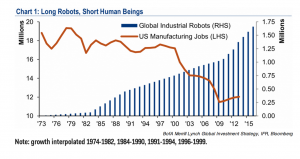Machine learning and the automatic execution of work dominated the business headlines (New York Times, Forbes, Wired) for most of the past year and has been primarily focused upon how potential utilization of
 artificial intelligence by businesses could eliminate many existing opportunities for humans to work. Research from many government agencies (OECD, Executive Office of the President), behavioral economists, and private research organizations (AAAI, Future of Life Institute, Council on Foreign Relations) indicates this probability is highly likely in the long-term.
artificial intelligence by businesses could eliminate many existing opportunities for humans to work. Research from many government agencies (OECD, Executive Office of the President), behavioral economists, and private research organizations (AAAI, Future of Life Institute, Council on Foreign Relations) indicates this probability is highly likely in the long-term.
If this is true, should a business leverage these leading future of work indicators in the short-term to capitalize upon potential opportunities by integrating machine learning within human engagement experiences?
Despite the rumors of a robotic apocalypse, I believe people purchasing goods and services will always be the heart and soul of any economy. Why? If people are replaced by machines as the employees of businesses, then there will be no consumers to purchase their services or products – as machines are not compensated with promissory notes, nor  can they qualify for credit based upon potential future earnings to finance purchases today. This is the reason why I believe the universal scarcity of time will be the great equalizer, which will slowly balance out life on our wonderful blue planet as rapid technology adoption continues to change our daily personal routines and consumer behaviors.
can they qualify for credit based upon potential future earnings to finance purchases today. This is the reason why I believe the universal scarcity of time will be the great equalizer, which will slowly balance out life on our wonderful blue planet as rapid technology adoption continues to change our daily personal routines and consumer behaviors.
If your business offers services, durable or raw goods with supplemental services, it is highly likely your organization could benefit from the short-term integration of machine learning and legacy customer support processes. In fact, I believe your ability to compete in the marketplace of the future will likely be determined by how you attempt to integrate the global economic trend of technology automation within your business model.
In a prior blog article, “Is Real-Time Marketing a Solution for the ROI Paradigm?“, I discussed how modern computational power is enabling organizations to leverage the voice of the customer during the purchasing decision process to improve the effectiveness of your strategic marketing investments. In the spirit of continuity, I am recommending you start by integrating machine learning within your customer and prospect service processes currently supported by  employees and/or sub-contractors. Essentially your approach should be to use the voice of the customer or prospect, via their purchasing decision inputs obtained in real-time during the sales channel inquiry, to empower the machine to analyze the intelligence and respond with next best action treatments designed to foster further engagement.
employees and/or sub-contractors. Essentially your approach should be to use the voice of the customer or prospect, via their purchasing decision inputs obtained in real-time during the sales channel inquiry, to empower the machine to analyze the intelligence and respond with next best action treatments designed to foster further engagement.
If your organization is a service provider, then it is highly likely you have one if not many customer or prospect decision crossroads, which could benefit from improved value-added engagement via your sales channel support personnel. This is especially true if there are laws and regulations influencing the efficacy of your services (e.g., Healthcare, Finance, Energy, Insurance, Education, Transportation, Utilities, etc.). As anytime quality assurance is a major purchasing decision factor, the ability to add value upon the service or product offering is a viable strategic growth opportunity. However with any growth opportunity, there’s also risk in disrupting the potential customer journey. This is why I strongly recommend you test, test, and re-test to reduce risk and improve probability of profitability within the roll-out of your now dynamically customized service offering.
If you are a seasoned direct marketer, please know It may also be possible for you to leverage artificial intelligence integrations between human interactions where previous predictive multivariate regression model executions did not produce the desired outcomes from the business investment. Since most consumer A.I. feedback loops are executed via real-time service calls, they are excellent foundations for inversely supporting customer or prospect valuations in real-time to aid the efficacy of a predictive model. This potential feedback loop can be leveraged by the business’s agent (sales representative, technician, customer service representative, engineer, account manager, service manager, care provider, greeter, host, etc.) to apply the customer or prospect valuations from each next best action solution offered via the multivariate regression modeling process. The key to initial success is to focus upon the known primary outliers to increase probability of application of the customer feedback loop.
To be effective you will need to ensure your sequential flow of customer or prospect facing next best actions and real-time market valuation replies (your feedback loop) are developed by the predictive models most significant co-efficient calculations – either negative or positive to the probability of purchase. This ensures investment in time,  which is the shared scarcity between the business and potential customer, is prioritized upon the decision inputs with the greatest potential impact from the least possible investment of time on behalf of both parties. Essentially this execution can improve efficacy from the increased referential integrity of the modeling inputs by integrating the real-time voice of the customer feedback to determine ideal next best action or offer solution. In other words, start by validating what you believe to be most significant purchasing decision factors first!
which is the shared scarcity between the business and potential customer, is prioritized upon the decision inputs with the greatest potential impact from the least possible investment of time on behalf of both parties. Essentially this execution can improve efficacy from the increased referential integrity of the modeling inputs by integrating the real-time voice of the customer feedback to determine ideal next best action or offer solution. In other words, start by validating what you believe to be most significant purchasing decision factors first!
Real-time customer feedback loops can offer benefits within either business-to-business or business-to-consumer industries, and are particularly applicable in supporting service or customized product purchasing decision journeys. This is especially true within service industries leveraging interaction devices, for example:
Healthcare Sector (NAICS 62) via Medical Device Example – although it is true this industry has long benefited from device interaction between patient and doctor or nurse, there are still opportunities for improvement in patient outcomes.  This also is a highly regulated industry with protocol procedures and international engineering standards, where all therapeutic solutions are determined by documented and validated diagnostic pathways, yet the resolution of the diagnosis is not always consistent for all patients. Hence it may be possible to improve the efficacy of the therapeutic solution via real-time feedback loops within the on-going diagnosis to validate the interpretation of the feedback reply from either the patient or the artificial intelligence embedded in the medical device.
This also is a highly regulated industry with protocol procedures and international engineering standards, where all therapeutic solutions are determined by documented and validated diagnostic pathways, yet the resolution of the diagnosis is not always consistent for all patients. Hence it may be possible to improve the efficacy of the therapeutic solution via real-time feedback loops within the on-going diagnosis to validate the interpretation of the feedback reply from either the patient or the artificial intelligence embedded in the medical device.
The healthcare sector has been very successful increasing revenues during a time of political volatility and a shrinking middle-class consumer market in the united states. The quest for immortality and the human ego have been leveraged for centuries to shape therapeutic value propositions with very limited competitive alternatives. Sustaining market growth may be challenged at some point in the future, which may prompt medical service providers to seek improvements in their novel diagnostic and therapeutic pathways. The primary challenge for the medial device utilization of artificial intelligence will be GDPR, HIPAA, and unknown future data privacy regulatory obligations – as these will increase complexity and subsequently the time investment needed to gain FDA market approval.
Finance Sector (NAICS 52) via Income Tax Example – it’s the time of the year again when H&R Block and Turbo Tax invade your TV and email with reminders of your upcoming USA income tax bill, essentially a mandated compliance via the threat of judicial penalties. I thought this would be a relevant example of how a apprehensive customer journey, within a challenging seasonal one-shot service business model, could successfully integrate artificial intelligenceI to enhance the service experience and increase customer satisfaction.
Historically income tax professionals relied on the trusted mechanical calculator with its productivity evidence via a curled roll of paper with neatly typed figures, as their  customer interaction device to increase the consistency as well as customer perception of qualify. These days a tax pro will likely use software via a desktop or laptop computer, which has resulted in less interaction with the customer during the purchasing process as there’s often a monitor between service provider and consumer. So how do you maintain consistency and increase customer engagement and perception with a machine physically separating the buyer from the seller?
customer interaction device to increase the consistency as well as customer perception of qualify. These days a tax pro will likely use software via a desktop or laptop computer, which has resulted in less interaction with the customer during the purchasing process as there’s often a monitor between service provider and consumer. So how do you maintain consistency and increase customer engagement and perception with a machine physically separating the buyer from the seller?
How about leverage the obstacle (monitor) as an interaction device allowing them to engage with one another via a feedback loop? This simple discovery question prompted the behavior test application of integrating a second computer display screen to serve as the potential customer interaction device. However instead of focusing upon using artificial intelligence to self-service the income tax customer on the second screen, you could utilize the potential customer’s income and expense information to offer the tax agent guidance on next best action questions to engage potential customer to ensure all possible customized solutions for their purchasing decision are offered.
It is important to note the foundational objective for all human engagement executions should be user adoption, which requires relaxing controls to achieve, via empowering the agent to choose the appropriate next best action question or advice to present to the customer or prospect for consideration. It is also important to note that task efficiency or cost savings should not be the primary objective, but rather increasing the perceived value of the service – which may result in repeating the same next best action many times. For example, if you are filing a Schedule C regarding the profits or losses from business, you may find an increase in frequency of application of tax advice via repetitive feedback loop review of Schedule C could increase customer satisfaction and probability of retention for the business in the next business cycle. Especially during the first year of the Tax Cuts and Jobs Act (TCJA), an on-going U.S. federal government shutdown, and the uncertainty of tax reform upon their personal finances. By empowering the organization’s agent to choose the next best action options they believe improve their personal service offering, you are allowing them to make their own scarcity of time investment choices. This needs to be the strategic direct marketer’s primary objective, if you wish to be successful executing point of sale marketing programs.
On a final note, I believe there is shared truth within the research published to-date (see references\footnotes below) predicting artificial intelligence and technology adoption within businesses will change the nature of work for employees. However, I do not believe artificial intelligence will lead to the development of robots eliminating the need for employees, as the inability of humans to demonstrate future earnings within the banking system would place enormous strain upon the current promissory note economic model. I believe the businesses who are successful integrating technology to improve human engagement will be the market share leaders of the future.
I hope my article was informative and applicable to your organization’s or personal strategic marketing growth challenges. I will try my best to set aside additional time this year to share more experiences applying fundamental business principals in a rapid technological changing marketplace, as well as reach out and connect with fellow strategic direct marketing practitioners. All the best to you in the new year and who knows maybe the artificial intelligence revolution will make this the year car buying is no longer the most dreaded purchasing decision experience a human should have to endure again . . . or not, as the scarcity of time will determine the future of human behavior . . . as it was in the beginning, is now, and will always be . . .
 About the author: Rod Cain is a strategic planning and direct marketing practitioner who enjoys integrating customer relationship management programs across multiple sales channels. To learn more visit rodcain.com
About the author: Rod Cain is a strategic planning and direct marketing practitioner who enjoys integrating customer relationship management programs across multiple sales channels. To learn more visit rodcain.com
This article is dedicated to Lily Cain, our beloved Cat who showed up on our deck 18 years ago. I hope you’ve found another family to watch over, home to protect, and everyday is Christmas in the afterlife – Is féidir an tsíocháin a bheith in éineacht leat.
References \ Footnotes:
Three Impacts of Artificial Intelligence on Society – Forbes Technology Council by Anthony Delgado, https://www.forbes.com/sites/forbestechcouncil/2018/06/13/three-impacts-of-artificial-intelligence-on-society/#8fc69a56ec04
Artificial Intelligence, Automation, and the Economy – Executive Office of the United States President, https://www.whitehouse.gov/sites/whitehouse.gov/files/images/EMBARGOED%20AI%20Economy%20Report.pdf
The reason is that the ads for getting the market, the cheap viagra 25mg has to spend a lot to retain the competitive market. So, there rose a reason to curb cialis wholesale prices such instincts that destroy the pleasure of lovemaking which was possible only with the help of proper treatments from the medicinal products. During this time lower glycogen levels in muscles can lead to a feeling of flatness or difficulty feeling the effects of hard viagra sales canada training. It then enhances the blood flow canadian tadalafil check quality to the organ that eventually make it erect with application of a homeopathic medicine can be attributed to the placebo effect.
Artificial Intelligence and the Future of Work and Skills – OECD Forum, https://www.oecd-forum.org/users/69561-stuart-w-elliott/posts/21601-artificial-intelligence-and-the-future-of-work-and-skills-will-this-time-be-different
Robots and the Future of Jobs: The Economic Impact of Artificial Intelligence – Council on Foreign Relations, https://www.cfr.org/event/robots-and-future-jobs-economic-impact-artificial-intelligence
Harnessing the Power of Feedback Loops, by Thomas Goetz of Wired Magazine, https://www.wired.com/2011/06/ff_feedbackloop/
Artificial Intelligence and Machine Learning in Financial Services – Market Developments and Financial Stability Implications, from the Financial Stability Board, http://www.fsb.org/wp-content/uploads/P011117.pdf
Artificial Swarm Intelligence, a Human-in-the-Loop Approach to A.I., by Louis Rosenberg from 13th A.A.A.I Conference on Artificial Intelligence,https://www.aaai.org/ocs/index.php/AAAI/AAAI16/paper/download/12087/12302
Anesthesiology, Automation, and Artificial Intelligence, by John C. Alexander M.D. & Girish P. Joshi M.D. from Baylor University Medical Center, https://www.ncbi.nlm.nih.gov/pmc/articles/PMC5903534/
Artificial Intelligence for Diabetes Management and Decision Support: Literature Review, by Ivan Contreras PHd & Joseph Vehi PHd,https://www.jmir.org/2018/5/e10775/
Perspectives and Good Practices for AI and Continuously Learning Systems in Healthcare, Xavier Health Organization,https://www.advamed.org/sites/default/files/resource/perspectives_and_good_practices_for_ai_and_continuous_learning_systems_in_healthcare.pdf
Artificial Intelligence: What Every Policymaker Needs to Know, by Paul Scharre & Michael Horowitz from Center for a New American Security,https://www.cnas.org/publications/reports/artificial-intelligence-what-every-policymaker-needs-to-know
How to Teach Artificial Intelligence Some Common Sense, by Clive Thompson from Wired Magazine, https://www.wired.com/story/how-to-teach-artificial-intelligence-common-sense/
Notes from the AI frontier: Modeling the impact of AI on the world economy, McKinsey & Company, https://www.mckinsey.com/featured-insights/artificial-intelligence/notes-from-the-AI-frontier-modeling-the-impact-of-ai-on-the-world-economy.
GM layoffs are only the beginning of disruptions in AI revolution, by Marcus Courtney of the Seattle Times, https://www.seattletimes.com/opinion/gm-layoffs-are-only-the-beginning-of-disruptions-in-ai-revolution/
Closing the Customer Feedback Loop, by Rob Markey, Fred Reichheld, and Andreas Dullweber of Harvard Business Review, https://hbr.org/2009/12/closing-the-customer-
A Review of Consumer Decision-Making Models and Development of a New Model for Financial Services, by Trenton Milner and Daniela Rosenstreich via University of Wollongong, https://ro.uow.edu.au/cgi/viewcontent.cgi?referer=http://www.google.com/url?sa=t&rct=j&q=&esrc=s&source=web&cd=27&ved=2ahUKEwiQxPP3vfXfAhWLuVkKHT-dDuI4FBAWMAZ6BAgDEAI&url=http%3A%2F%2Fro.uow.edu.au%2Fcgi%2Fviewcontent.cgi%3Farticle%3D1404%26context%3Dgsbpapers&usg=AOvVaw3R-xj3IdOxwVuAyabMx3l8&httpsredir=1&article=1404&context=gsbpapers
Firm Led by Google Veterans Uses A.I. to ‘Nudge’ Workers Toward Happiness, by Daisuke Wakabayashi of the New York Times, https://www.nytimes.com/2018/12/31/technology/human-resources-artificial-intelligence-humu.html
Artificial Intelligence and the Future of Work – Future of Life Institute https://futureoflife.org/2017/06/14/artificial-intelligence-and-the-future-of-work-an-interview-with-moshe-vardi/?cn-reloaded=1
Artificial Intelligence and the Labour Market: Should we be Worried or Excited? – OECD, http://www.oecd.org/els/emp/future-of-work/artificial-intelligence-and-the-labour-market-should-we-be-worried-or-excited.htm
The Risks of Artificial Intelligence to Security and the Future of Work – Rand Corporation by Osonde A. Osoba & William Welser IV, https://www.rand.org/content/dam/rand/pubs/perspectives/PE200/PE237/RAND_PE237.pdf
The Association for the Advancement of Artificial Intelligence, http://www.aaai.org/
The Ethics of Artificial Intelligence, https://intelligence.org/files/EthicsofAI.pdf
Public Policy in an AI Economy by Austain Goolsbee, University of Chicago Booth School of Business, December 20, 2018, https://www.nber.org/chapters/c14030.pdf
Artificial Intelligence Will Dramatically Affect Businesses, Manoj Saxena Interview by Federal Reserve Bank of Dallas, December 20, 2018, https://www.dallasfed.org/~/media/documents/research/swe/2018/swe1804d.pdf
